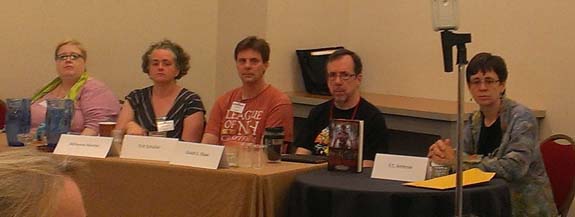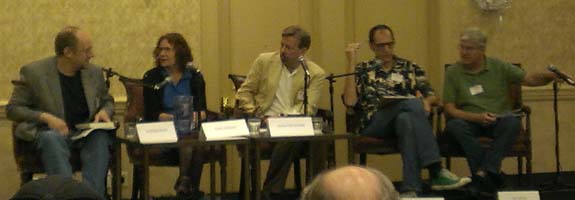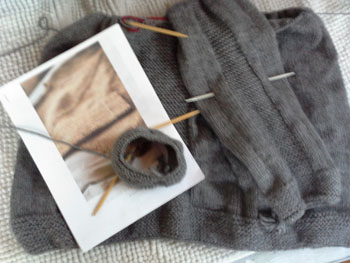Readercon 24 – July 13, 2013 – Saturday
Posted in Convention, Publishing, Readercon, Reading, Writing on July 13th, 2013Checked the crack in the windshield and it hadn’t gotten any bigger overnight — big yeah. Just hope it doesn’t do anything
awful until after we get home.
Got a late start this morning, so didn’t make a panel until noon, missing two earlier ones that I really, really, wanted to get to. Just one of those days. I’m now down to one coffee a day — and hating it, a lot.
Just lost everything below here twice as my spam software suddenly decided that my site wasn’t safe or didn’t exist — it couldn’t make up it’s mine so there was an immediate change of software and the misbehaving software is now in time out.
Noon – Constellations of Genres
Panel: John Crowley, Veronica Schanoes, James Patrick Kelly (leader), Ted Chiang, Gary K. Wolfe, and Kit Reed.
Description: On Readercon 23’s panel “Genre Transference,” James Patrick Kelly cited four genres a book can have: “The genre of the writer’s intent, the genre of reader expectation, the genre of the critical review, and the commercial genre.” Let’s dig deeper into this idea. Are there more genres than these four? How does the constellation of a book’s various genres change the reader’s experience, or the writer’s career?
As genres seem to be evaporating because the walls between genres seem to have become porous. The tropes of one genre are now showing up in others. However, often those who are not familiar with the originating genre of the tropes don’t have the same depth of understanding of why/how/where the trope is used. Then there was a lot about the conversation between the author and the text and the text and the reader and whether other genres want to talk to each other in any type of conversation.
1:00 PM – Authorial Metanarrative
Panel: Glenn Grant, Alex Dally MacFarlane, Theodora Goss (leader), Lila Garrott, Sonya Taaffe
Description: A number of authors build in subtle links between otherwise unconnected works. A link may not be something as literal as a common character or name; perhaps, instead, there’s a repeated trope or event. Leah Bobet, discussing Patricia A. McKillip’s works in a 2011 blog post, described this as writing “epic poetry, and the whole of [McKillip’s] output is the poem.” How do such links affect a reader’s interpretation of or approach to a body of work, and what motivates authors to link their works together?
Some author’s have put in links that connect their stories — these links can be a secondary character that shows up in a work where they don’t necessarily have a part, or events from one story are mentioned in another, or symbols reoccur in multiple stories. These can be either intended by the author or happy happenstance. Discussion of what does an author do when such reoccurring items are pointed out to them. Are they gifts to the readers or a frustration because to understand you have had to read all the author’s works not just a selection? Does it work between author’s or only for the one author? Can these items tell their own story across the author’s body of work?
2:00 PM – The Relationship of Reality and Fantasy
Panel: Andrea Hairston (leader), Julia Starkey, James Morrow, Scott H. Andrews, and Anil Menon.
Description: In a 2012 essay titled “PSA: Your Default Narrative Settings Are Not Apolitical,” Foz Meadows addressed the notion that “deliberately including POC, female and/or LGBTQ characters can only ever be a political action.” She demonstrated that history, the historical record, and commonly accepted historical narratives are in fact three distinct things, and pointed out the irony of fans who accept magic and dragons in their fantasy but balk at the idea of female pirates or a black Lancelot because they’re “unrealistic.” Whose reality does fantasy need to reflect in order to be believable? How can we use fantasy to shape and change our realities?
This more or less, in my opinion only (remember I’m caffeine deprived), focused on the nature of reality with a work and how it is best achieved. Also led into a discussion of Truth, truth, real, reality, and reality within context.
Visited the Book Shop (Dealers’ Room) — lots of really interesting books and I hope to get back tomorrow to buy a couple of the ones I spied today. Readercon’s Book Shop is just that all booksellers — new, used, and collectable, and sometimes all with the same bookseller. It’s a bookaholics dream come true.
7:00 PM – Woldbuilding by Worldseeing
Panel: Romie Stott, Sarah Smith, John Crowley (leader), and Harold Vedeler
Description: Kipling’s Kim, Mayhew’s London Labour and the London Poor, Dickens’s “sketches”… who is writing about the present day this way, and what can worldbuilders learn from these Victorian-era worldseers? All these observers were at some remove; how does observation differ when one is part of the culture one is observing?
The discussion focused on the need for writers to write what they know and if you don’t know to find out. You should get your facts straight. If writing modern urban fantasy, you should know the city of your story and get the details and environment of that city right. If a character works in a garage, pizza parlor, or coffee shop, for example, talk to someone about what it’s like to work there — learn the details of the job. Getting the background right helps to ground the story when the fantasy elements come into play.
8:00 PM – The Gender of Reading Shame
Panel: Natalie Luhrs (leader), Jordan Hamessley, Ann Tonsor Zeddies, Julia Rios, and Trent Zelazny.
Description: In a 2012 post on Book Riot, Amanda Nelson wrote about bookstore shoppers who display signs of shame or embarrassment about their reading choices. She concluded that this behavior is highly gendered: “If men read ‘unliterary’ but stereotypically masculine genres it’s fine. If women read ‘unliterary’ but stereotypically feminine genres it’s deserving of a brown paper bag in the form of increased e-reader sales so you can read in public in peace.” Our panelists discuss their own experiences with reading shame or lack thereof, whether the gender hypothesis holds true within the speculative fiction–reading community, and why we read books we’re ashamed of or feel shame about what we read.
First ‘unliterary’ was defined to be non-genre. As you can imagine this was a panel with lots of personal accounts as well as recent research and anecdotal impressions. There was also the problem of the title and description as it implied binary gender ignoring the spectrum of gender as it is today. Everyone agreed that having an ereader so that you didn’t have to deal with a book cover giving you away has taken a lot of the stigma of reading those items that you personal feel uncomfortable about.
As always your thoughts and impressions about the topics are welcome. Leave a comment.













